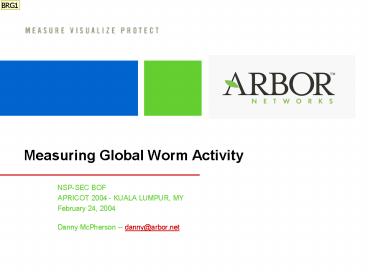Measuring Global Worm Activity PowerPoint PPT Presentation
1 / 23
Title: Measuring Global Worm Activity
1
Measuring Global Worm Activity
- NSP-SEC BOF
- APRICOT 2004 - KUALA LUMPUR, MY
- February 24, 2004
- Danny McPherson -- danny_at_arbor.net
2
Introduction
- Measure scan and worm activity, DDoS backscatter
- Capture-distillation methodology
- Near real-time alerting
- Scan or backscatter detection, description
- Long-term records
- Observe trends
- Ongoing project
- Fewer artifacts compared to point collection
- Can compare with direct observations
3
Measurement Infrastructure
- Use blackhole monitoring techniques
- Globally announced, unused /8
- Distill worm activity, summarize
4
Methodology
- Collect data to a globally announced unused /8
network. - Provided by a research partner
- Perform TCP handshake and grab payload at sampled
interval - Roughly 1/223 of entire IPv4 Internet address
space. - Collect
- Backscatter from spoofed sources
- Scanning and other activity destined for hosts
within /8
5
Measure What?
- Duration
- Protocol Distribution
- Counts packets, bytes, unique sources, etc..
- Target Distribution
- Wasted bandwidth
- Observe trends
6
Worm Impact
- Global
- Consumes bandwidth, operational overhead
- DDoS susceptibility via announced holes
- Local
- Resources in cleanup
- Potential to affect new machines locally
7
Duration
- Most are short, but some are longer than 100
minutes - June 2003 statistics
- 117,000 backscatter events logged
- 6800 high severity
- 8500 medium severity
- 1600 longer than 100 minutes
- 5000 between 10 and 100 minutes in duration
- Similar in recent months
8
Duration
9
Packets and Bytes
- Most are small, but some are very heavy
- June 2003 statistics
- 500 over 1 million packets per event
- 2400 over 100,000 packets per event
- 9400 over 100,000 bytes per event
- 1600 over 1 million bytes per event
- scaled to factor blackhole view (1/256)
- 3-10 fold increase over previous months
10
Target Distribution
- Targets are distributed all over the world
- Asia-Pacific, Europe, South America, North
America - Various types of targets
- government, network providers, universities,
banks, broadband - Most sites hit once or twice, small handful
appear commonly - various networks hit hundreds of times each
11
Protocol Distributions
- Inverted protocol distribution
- mid 2001 95 TCP
- late 2002 75 UDP
- current (2003) 90 UDP
- Transition away from SYN flood to generic
bandwidth attacks - 137/UDP, 139/UDP, 445/TCP common attack targets
- many attacks hit random ports
12
Protocol Distribution
13
Trends in Worm Incidents
- Demographics
- Korea no longer top spot (TLD analysis)!
- Global broadband still biggest source (2LD)
- Persistence
- Exploit trends
- Faster time to market?
- Escalated Threats
- DDoS agent carrier, spread is DDoS
- Faster cleanup
- Hours, not days
14
Worm Demographics
- Code Red Nimda
Blaster
15
Nimdas Persistence
- Nimda (September, 2001)
- Still persistent after 2 years
- Over one million hosts a day (August, 2003)
16
Blasters Activity Cycle
- Blaster (August, 2003)
- Circadian pattern
- Global TLD distribution
- 300-1000 hosts per hour
17
Exploit Trends in Worms
- Slightly faster time to market
- Code Red (2001) 30 days
- Nimda 42 days
- Sapphire 184 days
- Blaster under 30 days
- Still not 0 day
- Known vulnerabilities
- IDS signatures, firewall rules
- Hard to predict what will be a worm
18
Escalated Threats
- DDoS payload
- Code Red DDoS against one IP
- Blaster DDoS against hostname
- Deloder Arbitrary DDoS toolkit
- The spread is the DDoS
- Sapphires congestion
- Effects on routing tables
- Multicast group state (MSDP SA).
19
Faster Cleanup
- Were responding faster
- Filters, cleanup
- Measures as half life of observations
- Nimda cleanup rate 2-3 days
- Blaster cleanup rate 10 hours
20
Limitations
- Inferring activity via scan activity
- We only actively sample on port 80/TCP
- Use MD5 payload hashing to classify payloads
- Labor intensive
- Manual payload classification
- Limited visibility for some worms
- Worms which use enumerated networks can (and
have) ignored this network - Misses worms which fingerprint
- Misses worms which use target lists (mail, IM)
21
Conclusions
- Cumulative effect of frequent small attacks
- hundreds of small attacks per month for top
targets - cumulative effect of a very long lived attack
- Similar durations but larger packet and byte
counts - individual attacks have more sources, bandwidth
- higher packets per second
- Whats going on?
- Rapid increase in number of tools, availability
- Worms being tied to zombie creation - bot armies
22
Conclusions (cont.)
- The good news
- CR, Nimda, Blaster numbers down
- Blaster was quickly filtered
- Korea not seen heavily in Blaster
- Blackhole monitoring effective at estimations
- The bad news
- Nimda still persists after 2 years
- Global broadband networks are the main sources
for Blaster
23
Acknowledgements
- Jose Nazario
- Michael Bailey
- Dug Song

